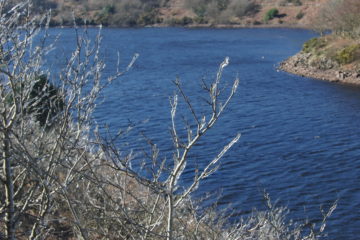Although less well-known than the sea cliffs of Cornwall or Lundy Island, the peaks of Dartmoor offer a unique challenge to climbers. Virtually every hill has a granite tor at the top of it and there are numerous quarries to tackle as well. These offer endless opportunities for all abilities. However, one thing you won’t find is crowds of other climbers, as the area remains a bit of a backwater in the climbing world, having been described as ‘the most underrated bouldering area in the UK’. While sport climbing, which involves placing permanent bolts in the rockface, is forbidden, both bouldering, which requires no protection, and traditional climbing can be enjoyed on Dartmoor. Whichever you choose, please do remember that climbing is a dangerous sport and Dartmoor granite can be particularly unforgiving.
For the first-time visitor, Haytor Rocks, with its distinctive double peak, makes a great starting point. As well as good climbing, there are fantastic panoramic views out across the moors. Nearby Hound Tor has over 100 routes, which range from easy to almost impossible! There are also numerous bouldering sites in this area of the moor, including Bonehill Rocks – this is probably the only site that gets really busy, although justifiably so, as the climbing is so good. For fewer people, try Easdon Rocks, Tunhill Rocks, Bell Tor or Honeybag Tor.
If you’re looking for a longer day out in a truly get-away-from-it-all setting, the tors of the high moors may be more your thing. New routes have recently been developed on Great Links Tor and Irishman’s Wall, both located in the northern part of the moor. You’re unlikely to meet anyone else at Combshead Tor, due to its isolated location in south Dartmoor, and will probably have the 150 boulder problems, which cover virtually every style and grade, to yourself. The Dewerstone, Dartmoor’s most extensive peak, sits in a wooded valley above the river Plym and is topped off by the 40m Devil’s Rock. The recent addition of some more challenging routes means that this location now offers something for everyone.
Whatever adventure you are planning, please remember that Dartmoor is a protected landscape, so please take a look at the Dartmoor Park Authority’s Code of Conduct before setting out. In particular, try not to remove any naturally occurring vegetation from the rock and be careful with the placement of protective gear. The use of chalk balls or liquid chalk is also encouraged, as it prevents chalk build up on the holds, which then require less brushing, which may damage the granite.
Climbing on Dartmoor is a year-round activity. In winter, you can escape the biting winds in one of the moor’s wooded valleys, which tend to get rather overgrown in the spring and summer, while the crags of the open moor are best tackled between spring and autumn. Unlike some other locations, climbing on Dartmoor can be particularly good in the summer, as the elevated and exposed position of many of the tors means that there is usually a cooling breeze. If the weather turns, or you’ve just had enough for the day, there’s always a welcoming pub nearby, or if you still need to get your climbing fix, there are artificial walls at Exeter, Buckfastleigh and Plymouth.


